The string PV inverter market is projected to grow from USD 20.9 billion in 2025 to USD 53.1 billion in 2035, reflecting a CAGR of 9.8%. This growth represents an absolute dollar opportunity of USD 32.2 billion over the decade. Annual growth shows steady expansion, starting from USD 20.9 billion in 2025, reaching USD 25.2 billion in 2028, USD 33.3 billion in 2031, and progressing to USD 48.4 billion by 2034. The consistent upward trend highlights strong market potential, providing manufacturers and suppliers with opportunities to expand production, enhance distribution networks, and capture a growing share of the global solar inverter market.
The absolute dollar opportunity emphasizes the significant growth potential in the string PV inverter market over the next ten years. Incremental growth from USD 20.9 billion in 2025 to USD 53.1 billion in 2035 underscores a cumulative increase of USD 32.2 billion. Key years, such as USD 27.6 billion in 2029 and USD 40.1 billion in 2033, indicate periods of accelerated adoption. This growth trajectory allows stakeholders to scale operations strategically, optimize supply chains, and enhance service offerings, ensuring they capture a meaningful portion of the expanding market throughout the 2025–2035 period.
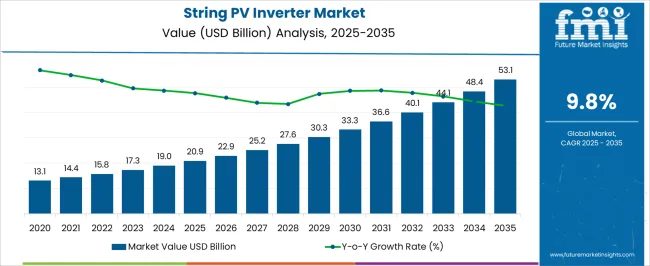
| Metric | Value |
|---|---|
| String PV Inverter Market Estimated Value in (2025 E) | USD 20.9 billion |
| String PV Inverter Market Forecast Value in (2035 F) | USD 53.1 billion |
| Forecast CAGR (2025 to 2035) | 9.8% |
The string PV inverter market is a segment of the broader solar inverter market, which also includes central inverters, microinverters, and hybrid inverters. In 2025, string PV inverters account for approximately 35% of the total solar inverter market, reflecting their importance in residential, commercial, and small utility-scale installations. With the parent market projected to grow from around USD 59.7 billion in 2025 to USD 116.5 billion in 2035, the string PV inverter segment’s growth from USD 20.9 billion in 2025 to USD 53.1 billion in 2035 at a CAGR of 9.8% represents roughly 30% of the total incremental growth in the parent market. Within the parent market, central inverters hold about 40% of the total value, microinverters account for 15%, and hybrid inverters contribute around 10%. The string PV inverter segment, with its high CAGR of 9.8%, demonstrates faster growth than other segments, highlighting its rising adoption across small- and medium-scale solar installations.
The absolute growth of USD 32.2 billion over the decade represents nearly 28% of total parent market expansion. This trend provides manufacturers and suppliers opportunities to scale production, expand distribution networks, and capture a larger share of the growing global solar inverter market.
The string PV inverter market is experiencing accelerated growth, supported by the global transition toward renewable energy and the rapid deployment of solar power systems. These inverters are essential for converting direct current from photovoltaic modules into grid-compatible alternating current, ensuring efficient integration into energy distribution networks.
Growth is being reinforced by favorable government policies, declining solar panel costs, and technological advancements that improve inverter efficiency and reliability. The market is also benefiting from the increasing adoption of smart grid infrastructure and real-time monitoring capabilities, enabling operators to optimize energy generation and manage fluctuations effectively.
Continuous innovation in design is reducing maintenance requirements while extending operational lifespans, providing better long-term returns on investment for both residential and commercial installations As solar energy adoption continues to expand across developed and emerging economies, the demand for high-efficiency, durable, and digitally connected string PV inverters is expected to remain strong, positioning the market for sustained growth over the coming decade.
The string pv inverter market is segmented by phase, connectivity, nominal output voltage, nominal output power, application, and geographic regions. By phase, string pv inverter market is divided into Three phase and Single phase. In terms of connectivity, string pv inverter market is classified into On grid and Standalone. Based on nominal output voltage, string pv inverter market is segmented into 230 - 400 V, ≤ 230 V, 400 - 600 V, and > 600 V. By nominal output power, string pv inverter market is segmented into 3 - 33 kW, 3 kW, 33 - 110 kW, and > 110 kW. By application, string pv inverter market is segmented into Commercial & industrial, Residential, and Utility. Regionally, the string pv inverter industry is classified into North America, Latin America, Western Europe, Eastern Europe, Balkan & Baltic Countries, Russia & Belarus, Central Asia, East Asia, South Asia & Pacific, and the Middle East & Africa.
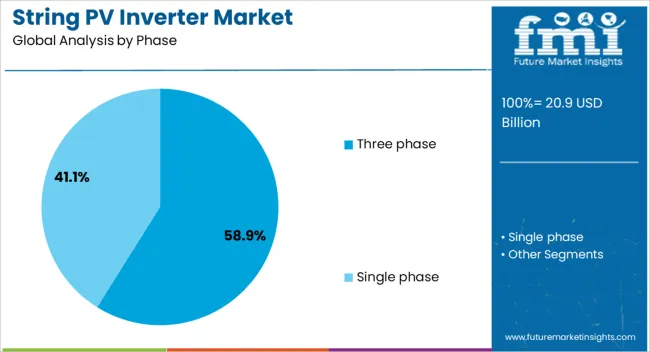
The three phase segment is projected to account for 58.9% of the string PV inverter market revenue share in 2025, making it the leading phase configuration. This dominance is being driven by its superior efficiency and capacity to handle higher power outputs, which are essential for large-scale commercial, industrial, and utility-scale solar installations. The ability to distribute electrical loads evenly across three phases reduces transmission losses and enhances system stability, supporting operational reliability in high-demand applications.
The segment is also benefiting from grid modernization initiatives that require equipment compatible with advanced distribution systems. Growing investments in solar farms, industrial complexes, and large commercial facilities are contributing to increased adoption.
In addition, technological advancements in three phase inverter designs are enabling higher efficiency rates, improved cooling systems, and advanced monitoring capabilities Compliance with stringent grid connection standards further supports the segment’s leadership, ensuring continued preference for three phase configurations in markets focused on maximizing energy output and operational efficiency.
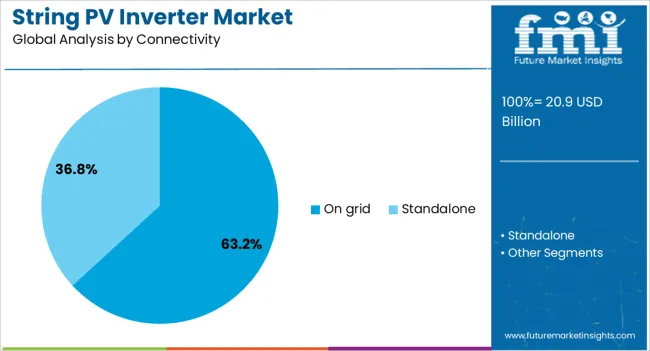
The on grid segment is anticipated to hold 63.2% of the string PV inverter market revenue share in 2025, reinforcing its position as the dominant connectivity type. Its leadership is being supported by the widespread deployment of grid-connected solar systems, driven by incentives such as feed-in tariffs, net metering programs, and renewable energy mandates.
On grid inverters allow surplus power generated by solar panels to be fed directly into the electricity grid, creating revenue opportunities for producers and ensuring efficient energy use. The segment is also benefiting from advancements in real-time monitoring, remote diagnostics, and automated grid compliance features, which enhance system reliability and reduce downtime.
Increasing adoption in both residential and commercial installations, particularly in urban areas with established grid infrastructure, is further boosting market share As energy policies increasingly emphasize grid integration of renewable sources, the demand for on grid string PV inverters with enhanced efficiency and compliance capabilities is expected to continue its strong upward trajectory.
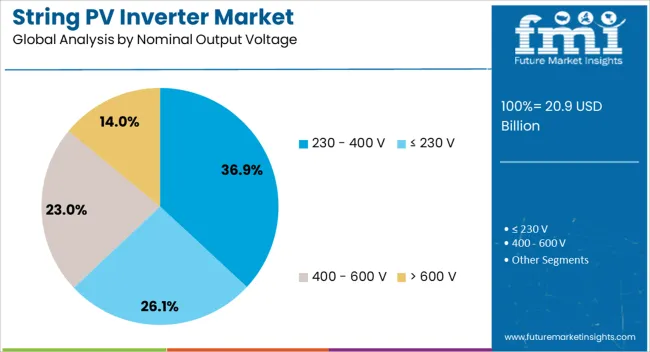
The 230 to 400 V segment is expected to account for 36.9% of the string PV inverter market revenue share in 2025, making it a leading nominal output voltage category. Its prominence is being driven by compatibility with a wide range of residential, commercial, and small-scale industrial applications, where standard voltage ranges align with existing electrical infrastructure. This voltage range supports optimal energy conversion efficiency while maintaining compliance with grid connection requirements in multiple regions.
The segment is also benefiting from its adaptability to different installation sizes, offering cost-effective solutions without compromising performance. Growing adoption in decentralized energy generation projects, including rooftop solar installations, is reinforcing demand.
Technological improvements in inverter components are enabling enhanced thermal management, better voltage regulation, and improved fault detection within this range. As energy systems evolve toward greater flexibility and integration with distributed resources, the 230 to 400 V segment is expected to maintain its strong market presence, supported by its versatility and proven performance in diverse operating environments.
The string PV inverter market is expanding due to growing demand for residential, commercial, and utility-scale solar installations. North America and Europe lead adoption with high-efficiency inverters, smart monitoring, and grid compliance features. Asia-Pacific shows rapid growth driven by renewable energy targets, rooftop solar expansion, and declining photovoltaic system costs. Manufacturers differentiate through conversion efficiency, monitoring capabilities, and modularity. Regional differences in solar policies, grid infrastructure, and energy tariffs strongly influence adoption, system performance, and global market competitiveness.
String PV inverters are increasingly adopted for residential and commercial solar systems due to their efficiency, modularity, and cost-effectiveness. North America and Europe focus on high-efficiency, multi-MPPT inverters with advanced monitoring and connectivity features to optimize rooftop and small-scale commercial installations. Asia-Pacific markets adopt affordable string inverters for growing rooftop and small commercial solar projects. Differences in solar irradiance, system size, and grid connectivity requirements affect inverter sizing, MPPT configurations, and integration features. Leading suppliers offer high-reliability, smart inverters with IoT-enabled monitoring, while regional manufacturers focus on cost-effective, easy-to-install solutions. Adoption contrasts between developed and emerging markets shape system design, efficiency optimization, and competitiveness in the global string PV inverter market.
Conversion efficiency, reliability, and modular design are critical factors in string PV inverter adoption. North America and Europe emphasize inverters with high conversion efficiency, thermal management, and extended warranties to maximize solar energy output and system lifespan. Asia-Pacific markets prioritize inverters that balance cost, performance, and ease of installation for large-scale rooftop or decentralized solar systems. Differences in operating temperatures, shading conditions, and maintenance infrastructure influence inverter selection, MPPT performance, and modular scalability. Leading suppliers provide modular, plug-and-play inverters with advanced diagnostics and energy optimization algorithms, while regional players offer simple, reliable systems at lower costs. Efficiency and design contrasts drive adoption, operational performance, and competitiveness globally.
Regulatory compliance and smart monitoring capabilities significantly impact string PV inverter adoption. North America and Europe enforce stringent grid codes and net metering regulations, requiring inverters with anti-islanding protection, reactive power control, and remote monitoring. Asia-Pacific markets have varying compliance levels; developed countries adopt strict international standards, while emerging regions follow flexible local norms. Differences in grid stability, regulatory enforcement, and monitoring infrastructure influence inverter design, safety features, and deployment speed. Leading suppliers integrate advanced monitoring, fault detection, and remote control capabilities, while regional manufacturers provide practical, compliant solutions. Grid compliance and monitoring contrasts shape adoption, operational reliability, and competitive positioning globally.
Government incentives, energy tariffs, and cost considerations are major drivers for string PV inverter adoption. North America and Europe focus on maximizing return on investment with high-efficiency, long-lasting inverters under supportive feed-in tariff schemes.
Asia-Pacific markets prioritize affordable, modular inverters to expand solar penetration under varying subsidy and incentive frameworks. Differences in policy support, electricity pricing, and financing mechanisms influence inverter selection, installation scale, and adoption pace. Leading suppliers provide energy-optimized, high-performance inverters for long-term value, while regional players offer economical solutions for cost-sensitive markets. Policy and cost contrasts drive adoption, project feasibility, and competitiveness in the global string PV inverter market.
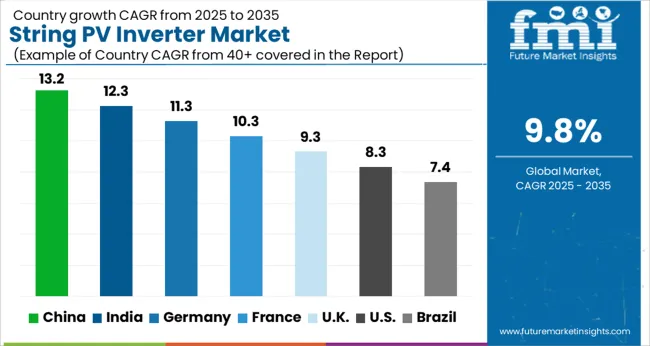
| Country | CAGR |
|---|---|
| China | 13.2% |
| India | 12.3% |
| Germany | 11.3% |
| France | 10.3% |
| UK | 9.3% |
| USA | 8.3% |
| Brazil | 7.4% |
The global string PV inverter market is projected to grow at a 9.8% CAGR through 2035, driven by demand in solar power systems, residential and commercial photovoltaic installations, and utility-scale renewable projects. Among BRICS nations, China led with 13.2% growth as large-scale manufacturing and deployment across solar energy projects were executed, while India at 12.3% expanded production and integration to meet rising renewable energy requirements. In the OECD region, Germany at 11.3% maintained steady adoption under strict regulatory and grid compliance standards, while the United Kingdom at 9.3% implemented string PV inverters across commercial, industrial, and residential solar installations. The USA, growing at 8.3%, advanced deployment in utility and distributed solar systems while adhering to federal and state-level renewable energy regulations. This report includes insights on 40+ countries; the top countries are shown here for reference.
The string PV inverter market in China is projected to grow at a CAGR of 13.2%, driven by the rising deployment of solar power plants, commercial rooftop installations, and utility scale solar projects. Adoption is being encouraged by inverters that provide high efficiency, reliability, and smart monitoring capabilities. Manufacturers are being urged to supply cost effective, durable, and technologically advanced solutions. Distribution through solar EPC companies, project developers, and industrial suppliers is being strengthened. Research in energy efficiency optimization, grid integration, and inverter reliability is being conducted. Increasing renewable energy capacity, government incentives for solar projects, and rapid industrial adoption are considered key factors driving the string PV inverter market in China.
In India, the string PV inverter market is expected to grow at a CAGR of 12.3%, supported by adoption in rooftop solar, utility scale installations, and commercial solar projects. Emphasis is being placed on inverters that provide efficiency, durability, and smart energy management. Local manufacturers are being encouraged to develop cost effective, reliable, and high performance solutions. Distribution through solar EPCs, project developers, and industrial suppliers is being expanded. Awareness campaigns promoting solar adoption and energy efficiency are being conducted. Expansion of renewable energy targets, industrial solar adoption, and government subsidy programs are recognized as primary drivers of the string PV inverter market in India.
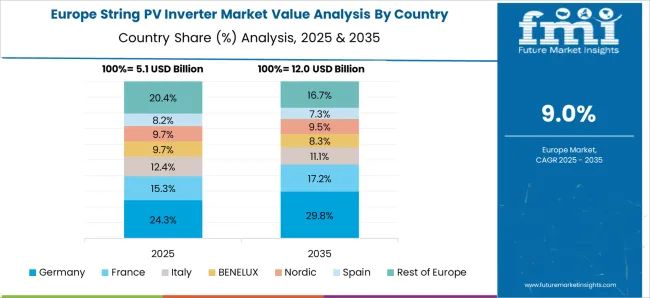
Germany is witnessing steady growth in the string PV inverter market at a CAGR of 11.3%, driven by demand from commercial solar projects, residential rooftop installations, and industrial solar systems. Adoption is being encouraged by inverters that ensure high efficiency, durability, and integration with smart grid solutions. Manufacturers are being urged to supply advanced, reliable, and energy efficient solutions. Distribution through solar project developers, EPC companies, and industrial suppliers is being optimized. Research in grid integration, inverter reliability, and automation features is being pursued. Expansion of renewable energy initiatives, energy efficiency policies, and commercial adoption are considered key factors driving the string PV inverter market in Germany.
The string PV inverter market in the United Kingdom is projected to grow at a CAGR of 9.3%, supported by adoption in residential rooftops, commercial solar, and utility scale projects. Adoption is being emphasized for inverters that provide efficiency, reliability, and smart energy management. Manufacturers are being encouraged to supply durable, cost effective, and high performance solutions. Distribution through solar developers, EPC companies, and industrial suppliers is being strengthened. Demonstration projects and pilot installations are being conducted to promote inverter performance and reliability. Expansion of renewable energy programs, rooftop solar adoption, and energy efficiency initiatives are recognized as major contributors to the string PV inverter market in the United Kingdom.
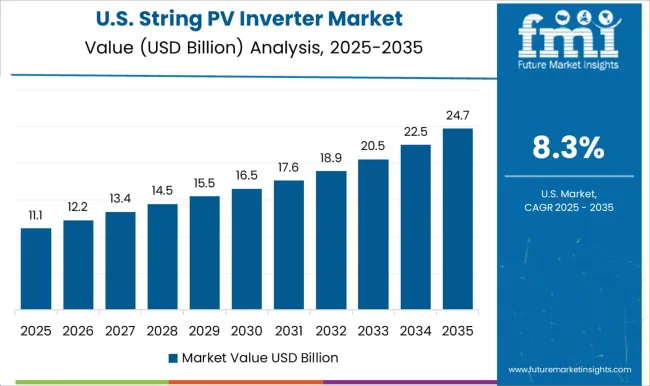
The string PV inverter market in the United States is projected to grow at a CAGR of 8.3%, driven by adoption in commercial, residential, and utility scale solar projects. Adoption is being encouraged by inverters that provide high efficiency, reliability, and smart monitoring features. Manufacturers are being urged to develop advanced, cost effective, and durable solutions. Distribution through solar EPCs, project developers, and industrial suppliers is being maintained. Research in inverter automation, grid compatibility, and operational efficiency is being pursued. Growth of residential and commercial solar installations, renewable energy policies, and industrial solar adoption are considered key drivers of the string PV inverter market in the United States.
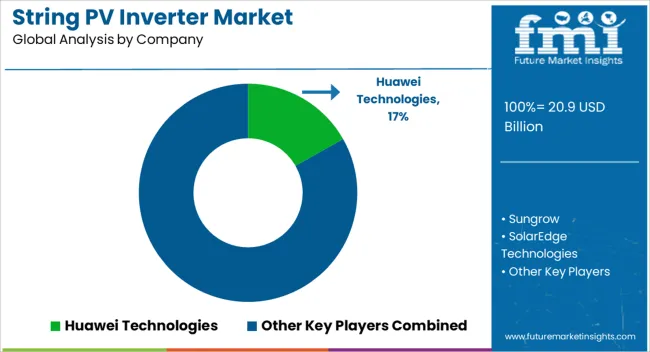
The string PV inverter market is shaped by a range of leading suppliers who provide advanced energy conversion solutions for residential, commercial, and utility-scale solar installations. Key players in this market include Huawei Technologies, Sungrow, SolarEdge Technologies, GoodWe, Growatt New Energy, SMA Solar Technology, Canadian Solar, Delta Electronics, Siemens, Ingeteam Power Technology, Solis Inverter, and Sineng Electric. These suppliers are known for offering high-efficiency, reliable, and scalable inverters that optimize solar energy generation while ensuring safety and system longevity. Their products are designed to meet global standards and support smart energy management in solar PV systems. Additional suppliers, such as SMA Solar Technology, Canadian Solar, and Ingeteam Power Technology, contribute to market growth by providing innovative inverter technologies, including string inverters with module-level monitoring, grid-support functionalities, and enhanced communication protocols. Companies like SolarEdge and Huawei Technologies lead in integrating smart inverter features, maximizing energy yield, and enabling seamless integration with energy storage systems. These advancements ensure that end-users can achieve greater operational efficiency and improved return on investment from solar PV systems. Overall, these leading suppliers drive the string PV inverter market through continuous innovation, quality product offerings, and global reach. Their focus on energy efficiency, reliability, and system intelligence enables widespread adoption of solar energy solutions across diverse regions. By addressing the increasing demand for renewable energy and supporting the transition to sustainable power generation, these companies play a pivotal role in advancing the solar inverter market, ensuring that residential, commercial, and industrial consumers have access to cutting-edge, efficient, and scalable solar energy solutions.
| Item | Value |
|---|---|
| Quantitative Units | USD 20.9 Billion |
| Phase | Three phase and Single phase |
| Connectivity | On grid and Standalone |
| Nominal Output Voltage | 230 - 400 V, ≤ 230 V, 400 - 600 V, and > 600 V |
| Nominal Output Power | 3 - 33 kW, 3 kW, 33 - 110 kW, and > 110 kW |
| Application | Commercial & industrial, Residential, and Utility |
| Regions Covered | North America, Europe, Asia-Pacific, Latin America, Middle East & Africa |
| Country Covered | United States, Canada, Germany, France, United Kingdom, China, Japan, India, Brazil, South Africa |
| Key Companies Profiled | Huawei Technologies, Sungrow, SolarEdge Technologies, GoodWe, Growatt New Energy, SMA Solar Technology, Canadian Solar, Delta Electronics, Siemens, Ingeteam Power Technology, Solis Inverter, and Sineng Electric |
| Additional Attributes | Dollar sales vary by inverter type, including single-phase and three-phase string inverters; by application, such as residential, commercial, and utility-scale solar installations; by end-use, spanning homeowners, businesses, and energy developers; by region, led by North America, Europe, and Asia-Pacific. Growth is driven by rising solar energy adoption, demand for efficient energy conversion, and smart grid integration. |
The global string pv inverter market is estimated to be valued at USD 20.9 billion in 2025.
The market size for the string pv inverter market is projected to reach USD 53.1 billion by 2035.
The string pv inverter market is expected to grow at a 9.8% CAGR between 2025 and 2035.
The key product types in string pv inverter market are three phase, single phase, _low power (≤ 99 kw) and _high power (> 99 kw).
In terms of connectivity, on grid segment to command 63.2% share in the string pv inverter market in 2025.






Our Research Products

The "Full Research Suite" delivers actionable market intel, deep dives on markets or technologies, so clients act faster, cut risk, and unlock growth.

The Leaderboard benchmarks and ranks top vendors, classifying them as Established Leaders, Leading Challengers, or Disruptors & Challengers.

Locates where complements amplify value and substitutes erode it, forecasting net impact by horizon

We deliver granular, decision-grade intel: market sizing, 5-year forecasts, pricing, adoption, usage, revenue, and operational KPIs—plus competitor tracking, regulation, and value chains—across 60 countries broadly.

Spot the shifts before they hit your P&L. We track inflection points, adoption curves, pricing moves, and ecosystem plays to show where demand is heading, why it is changing, and what to do next across high-growth markets and disruptive tech

Real-time reads of user behavior. We track shifting priorities, perceptions of today’s and next-gen services, and provider experience, then pace how fast tech moves from trial to adoption, blending buyer, consumer, and channel inputs with social signals (#WhySwitch, #UX).

Partner with our analyst team to build a custom report designed around your business priorities. From analysing market trends to assessing competitors or crafting bespoke datasets, we tailor insights to your needs.
Supplier Intelligence
Discovery & Profiling
Capacity & Footprint
Performance & Risk
Compliance & Governance
Commercial Readiness
Who Supplies Whom
Scorecards & Shortlists
Playbooks & Docs
Category Intelligence
Definition & Scope
Demand & Use Cases
Cost Drivers
Market Structure
Supply Chain Map
Trade & Policy
Operating Norms
Deliverables
Buyer Intelligence
Account Basics
Spend & Scope
Procurement Model
Vendor Requirements
Terms & Policies
Entry Strategy
Pain Points & Triggers
Outputs
Pricing Analysis
Benchmarks
Trends
Should-Cost
Indexation
Landed Cost
Commercial Terms
Deliverables
Brand Analysis
Positioning & Value Prop
Share & Presence
Customer Evidence
Go-to-Market
Digital & Reputation
Compliance & Trust
KPIs & Gaps
Outputs
Full Research Suite comprises of:
Market outlook & trends analysis
Interviews & case studies
Strategic recommendations
Vendor profiles & capabilities analysis
5-year forecasts
8 regions and 60+ country-level data splits
Market segment data splits
12 months of continuous data updates
DELIVERED AS:
PDF EXCEL ONLINE
String Power Conversion System(PCS) Market Size and Share Forecast Outlook 2025 to 2035
Stringer Pallets Market Size and Share Forecast Outlook 2025 to 2035
Understanding Market Share Trends in String Cheese Production
String Inverter Market Size and Share Forecast Outlook 2025 to 2035
Astringent Skin Care Products Market Analysis - Size and Share Forecast Outlook 2025 to 2035
Astringents Market Analysis - Size and Share Forecast Outlook 2025 to 2035
Three Phase String Inverter Market Size and Share Forecast Outlook 2025 to 2035
Single Phase String Inverter Market Size and Share Forecast Outlook 2025 to 2035
PV Power Forecasting System Market Size and Share Forecast Outlook 2025 to 2035
PVPP Beer Stabilizer Market Size and Share Forecast Outlook 2025 to 2035
PVC-M High Impact Resistant Water Supply Pipe Market Size and Share Forecast Outlook 2025 to 2035
PVC UV Stabilizer Market Size and Share Forecast Outlook 2025 to 2035
PVT Collectors Market Size and Share Forecast Outlook 2025 to 2035
PVC Electrical Conduit Market Size and Share Forecast Outlook 2025 to 2035
PVC Cling Film Market Size and Share Forecast Outlook 2025 to 2035
PV Combiner Box Market Size and Share Forecast Outlook 2025 to 2035
PVC Tapes Market Size and Share Forecast Outlook 2025 to 2035
PVC Footwear Market Analysis by Growth, Trends and Forecast from 2025 to 2035
PVC Packing Straps Market Report – Key Trends & Forecast 2025 to 2035
PV Module Encapsulant Film Market Analysis by Material Type, Application, Thickness, Weight, End-Use, and Region Forecast through 2035

Thank you!
You will receive an email from our Business Development Manager. Please be sure to check your SPAM/JUNK folder too.
Chat With
MaRIA